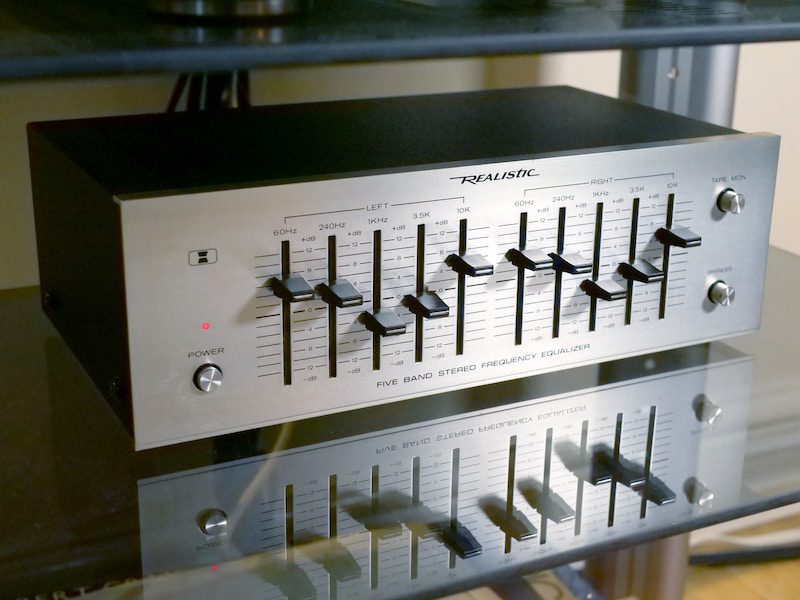EQ is a fundamental concept in audio that has been around for decades. It adjusts the balance of distinct frequency components in an audio signal. EQ can correct issues with the sound, enhance certain aspects of the audio, or achieve a desired sound.
EQ, or equalization, alters the balance between frequency components of an audio signal. It is essential for music production, live sound reinforcement, and broadcasting. EQ is used to enhance sound quality, reduce noise, and eliminate feedback.
There are different types of EQ, including graphic, parametric, and shelving EQ. Each type has its unique characteristics and applications. Understanding the basics of EQ is crucial for anyone who wants to work with audio, whether for professional or personal use. In this article, we will explore the concept of EQ in more detail, including its history, types, and applications.
Table of Contents

What is EQ?
EQ can be applied to various audio sources such as music, speech, and sound effects. It is an essential tool for audio engineers, producers, and musicians who want to create high-quality audio recordings.
EQ is used to cut or boost certain frequency ranges in an audio signal, which can help remove unwanted noise or emphasize specific sound elements.
Definition of EQ
EQ is a process of adjusting the balance between frequency components of an audio signal. It is done by cutting or boosting specific frequencies of the sound wave.
The human ear can hear frequencies ranging from 20Hz to 20kHz. EQ allows the sound engineer to adjust the balance of these frequencies to make the sound more pleasing to the listener.
Types of EQ
There are two types of EQ: graphic and parametric. Graphic EQ uses a fixed set of frequency bands to be boosted or cut by a certain amount. The bands are arranged in a graphical display, hence the name.
On the other hand, Parametric EQ allows the sound engineer to adjust each band’s gain, center frequency, and bandwidth. This gives more precise control over the sound.
Another type of EQ is shelving EQ, which boosts or cuts all frequencies below or above a certain point. This is useful for adjusting the bass or treble of a sound. High-pass and low-pass filters are also types of EQ that allow only frequencies within a range to pass through.
How Does EQ Work?
Equalization (EQ) is a process that adjusts the balance between different frequency components of an audio signal. EQ enhances or reduces specific frequencies, an essential tool in music production and sound engineering.
Sound engineers and producers can achieve a better mix and create a more balanced and pleasing sound by understanding how EQ works.
Frequency Bands
EQ works by dividing the audio spectrum into different frequency bands. Each frequency band corresponds to a specific range of frequencies, such as bass, midrange, and treble. The number of frequency bands can vary depending on the EQ device or software being used.
For example, a graphic equalizer may have 10 or more frequency bands, while a simple EQ plugin may only have three or four.
Each frequency band can be modified separately, allowing users to boost or cut specific frequencies. The adjustments can be made using sliders, knobs, or other controls, depending on the EQ device or software. The amount of boost or cut is measured in decibels (dB), and the center frequency of each band can be changed to target specific frequencies.
Adjusting EQ
Adjusting EQ requires understanding the frequency spectrum and how different frequencies affect the overall sound. For example, boosting the bass frequencies can add warmth and depth to a mix, while reducing the midrange frequencies can create a more distant and airy sound. However, too much cutting or boosting can result in an unnatural or unbalanced sound.
Professional sound engineers and producers often use EQ and other tools, such as compression, reverb, and delay, to achieve the desired sound. EQ can correct problems in a mix, enhance certain instruments or vocals, or create a specific mood or atmosphere.
It is important to note that EQ is not a magic tool that can fix all problems or make a bad recording sound great. It is a tool that requires skill, experience, and a good ear to use effectively. With practice and experimentation, however, anyone can learn how to use EQ to improve their mixes and create better-sounding music.
Applications of EQ
Equalization, or EQ, is a powerful tool with many audio applications. Here are some of the most common applications of EQ:
Music Production
EQ shapes the tonal balance of individual tracks and the overall mix in music production. For example, a producer might use EQ to boost the bass frequencies of a kick drum, cut the harshness of a vocal track, or add sparkle to a guitar solo.
EQ can also create separation between different instruments and fix problems in a recording, such as removing unwanted background noise or resonances.
Live Sound
EQ balances the sound of different instruments and voices in a live sound mix. This is especially important in a live setting, where the room’s acoustics and the speakers’ placement can affect the sound.
A live sound engineer might use EQ to cut the low frequencies of a guitar amp to prevent it from muddying up the mix or to boost the high frequencies of a cymbal to make it more audible. EQ can also be used to prevent feedback, which occurs when a microphone picks up the sound from a speaker and creates a loop of sound that gets louder and louder.
Broadcasting
In broadcasting, EQ ensures the audio sounds good on various playback systems. This is important because people listen to radio and TV on everything from high-end home theater systems to tiny earbuds.
A broadcaster might use EQ to boost the midrange frequencies of a voice to make it more intelligible on small speakers or to cut the bass frequencies of a music track to prevent it from overwhelming the dialogue. EQ can also ensure that the audio complies with broadcasting standards, such as the loudness standards set by the FCC.
EQ Tips and Techniques
Boost vs Cut
When using EQ, it’s important to understand the difference between boosting and cutting. Boosting a frequency will increase the volume of that frequency while cutting will decrease it. Using EQ sparingly and with intention is important, as too much boosting or cutting can result in an unnatural sound.
Using EQ to Fix Problems
EQ can be a powerful tool for fixing problems in a mix. For example, a high-pass filter can cut out unwanted frequencies if there is too much low-end rumble in a recording. Similarly, if a vocal track is too harsh or sibilant, a de-esser can tame those frequencies.
Using EQ for Creative Purposes
EQ can also be used for creative purposes, such as shaping the tone of a sound or creating interesting effects. For example, boosting the midrange frequencies of a guitar can give it a more prominent and cutting sound, while cutting the highs can give it a darker, more mellow tone.
EQ can also create a sense of space or depth by boosting or cutting certain frequencies to simulate the sound of a room or environment.
Overall, EQ is a, effective tool for shaping the sound of a mix, but it should be used with intention and care. A producer or engineer can create a more balanced, natural, and compelling sound by understanding the different techniques and approaches to EQ.
- Review of the ALABS IRON MINI-WL: A Powerhouse Wireless Microphone - October 4, 2023
- What is a Saturator in Music Production: A Brief Explanation - May 11, 2023
- What Are Rotary DJ Mixers? An Overview - May 11, 2023
SoundStudiomagic.com is a participant in the Amazon Services LLC Associates Program, an affiliate advertising program designed to provide a means for sites to earn advertising fees by advertising and linking to Amazon.com. We also participate in other affiliate programs which compensate us for referring traffic.

